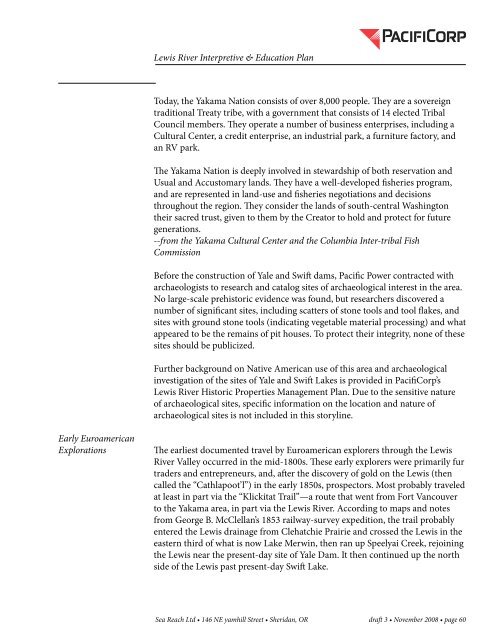The Lewis River Hydroelectric Projects - PacifiCorp
The Lewis River Hydroelectric Projects - PacifiCorp
The Lewis River Hydroelectric Projects - PacifiCorp
Create successful ePaper yourself
Turn your PDF publications into a flip-book with our unique Google optimized e-Paper software.
<strong>Lewis</strong> <strong>River</strong> Interpretive & Education Plan<br />
Today, the Yakama Nation consists of over 8,000 people. <strong>The</strong>y are a sovereign<br />
traditional Treaty tribe, with a government that consists of 14 elected Tribal<br />
Council members. <strong>The</strong>y operate a number of business enterprises, including a<br />
Cultural Center, a credit enterprise, an industrial park, a furniture factory, and<br />
an RV park.<br />
<strong>The</strong> Yakama Nation is deeply involved in stewardship of both reservation and<br />
Usual and Accustomary lands. <strong>The</strong>y have a well-developed fisheries program,<br />
and are represented in land-use and fisheries negotiations and decisions<br />
throughout the region. <strong>The</strong>y consider the lands of south-central Washington<br />
their sacred trust, given to them by the Creator to hold and protect for future<br />
generations.<br />
--from the Yakama Cultural Center and the Columbia Inter-tribal Fish<br />
Commission<br />
Before the construction of Yale and Swift dams, Pacific Power contracted with<br />
archaeologists to research and catalog sites of archaeological interest in the area.<br />
No large-scale prehistoric evidence was found, but researchers discovered a<br />
number of significant sites, including scatters of stone tools and tool flakes, and<br />
sites with ground stone tools (indicating vegetable material processing) and what<br />
appeared to be the remains of pit houses. To protect their integrity, none of these<br />
sites should be publicized.<br />
Further background on Native American use of this area and archaeological<br />
investigation of the sites of Yale and Swift Lakes is provided in <strong>PacifiCorp</strong>’s<br />
<strong>Lewis</strong> <strong>River</strong> Historic Properties Management Plan. Due to the sensitive nature<br />
of archaeological sites, specific information on the location and nature of<br />
archaeological sites is not included in this storyline.<br />
Early Euroamerican<br />
Explorations<br />
<strong>The</strong> earliest documented travel by Euroamerican explorers through the <strong>Lewis</strong><br />
<strong>River</strong> Valley occurred in the mid-1800s. <strong>The</strong>se early explorers were primarily fur<br />
traders and entrepreneurs, and, after the discovery of gold on the <strong>Lewis</strong> (then<br />
called the “Cathlapoot’l”) in the early 1850s, prospectors. Most probably traveled<br />
at least in part via the “Klickitat Trail”—a route that went from Fort Vancouver<br />
to the Yakama area, in part via the <strong>Lewis</strong> <strong>River</strong>. According to maps and notes<br />
from George B. McClellan’s 1853 railway-survey expedition, the trail probably<br />
entered the <strong>Lewis</strong> drainage from Clehatchie Prairie and crossed the <strong>Lewis</strong> in the<br />
eastern third of what is now Lake Merwin, then ran up Speelyai Creek, rejoining<br />
the <strong>Lewis</strong> near the present-day site of Yale Dam. It then continued up the north<br />
side of the <strong>Lewis</strong> past present-day Swift Lake.<br />
Sea Reach Ltd • 146 NE yamhill Street • Sheridan, OR draft 3 • November 2008 • page 60
















